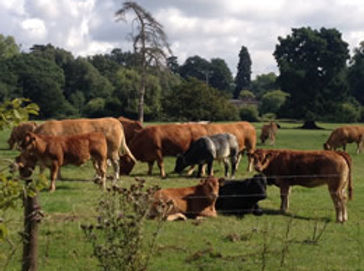Conservation at Thornham
Exciting projects include leaving large areas of arable land as bare soil throughout the spring and early summer to provide nesting areas for turtle dove, lapwing and other rare birds. Other areas are left uncropped during the winter months providing weed seeds and grain, which are vital for the birds when food is sparse. Blocks of land are planted to produce seeds for birds and other areas are planted to produce pollen and nectar for insects and butterflies.
Norah's Meadow
Nora’s meadow, by Thornham Parva church, is designated a County Wildlife Site by the Suffolk Wildlife Trust. The field has never been grazed and has never received any applications of fertilizer or chemicals. Swathes of orchids, vetches and ox-eye daisies create a rare colourful remnant of an English landscape long since lost. One late cut each year preserves the quality of the grassland and the hay has been moved to other areas on the Estate to spread the seed and recreate Nora’s meadow.


Woodland
Woodland areas are scattered throughout the Estate - pedunculate oak, ash, hazel and field maple are the dominant species. Some areas are ancient semi-natural woodlands that have been part of the landscape for many hundreds of years. With tree diseases spreading throughout England, sadly many oaks on the Estate are already showing signs of Acute Oak Decline. These trees are being felled and removed. The other major tree disease of recent times, Ash Dieback, is a fungal disease which has not yet reached Thornham. The woods are being closely monitored but if the disease does arrive then little can be done to mitigate its devastating effects. Management of the 340 acres of woodland is a continuous process with thinning work, essential to preserving the health of the woodlands and the ground flora, carried out on the Estate every year. New planting of trees and hedges is also undertaken where trees are being lost or where hedges have been removed.

Parkland
The parkland and grassland on the Estate is grazed by sheep, horses and cattle and most is managed without the use of chemicals and fertilizer. The parkland has over 220 trees of various ages and with oaks, limes, horse chestnut, hawthorn and wellingtonia the dominant species. Some oaks are old pollards - traditionally trees were pollarded for one of two reasons: for fodder for livestock or for wood. Fodder pollards produced "pollard hay", which was used as livestock feed; they were pruned at intervals of two to six years so their leafy material would be most abundant. Wood pollards were pruned at longer intervals of eight to fifteen years, a pruning cycle that tended to produce upright poles favoured for fence rails and posts. As a consequence of pollarding, trees survive to a great age and some oaks at Thornham are hundreds of years old. There are many ancient earthworks throughout the park, old roadways and tracks and old hedge lines and banks.


